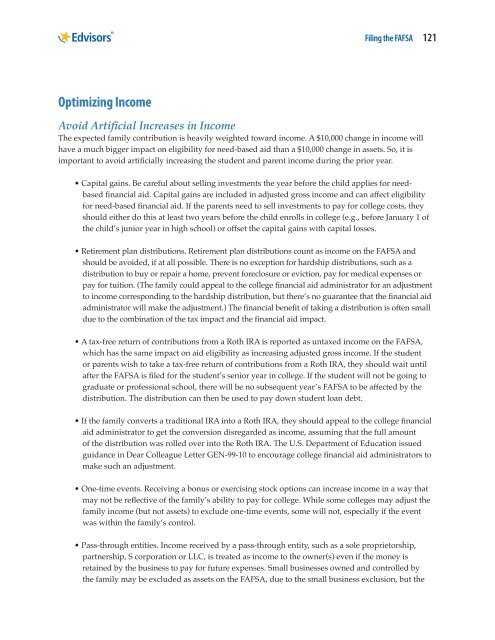filing-the-fafsa-2015-2016-edition
filing-the-fafsa-2015-2016-edition
filing-the-fafsa-2015-2016-edition
You also want an ePaper? Increase the reach of your titles
YUMPU automatically turns print PDFs into web optimized ePapers that Google loves.
Filing <strong>the</strong> FAFSA 121<br />
Optimizing Income<br />
Avoid Artificial Increases in Income<br />
The expected family contribution is heavily weighted toward income. A $10,000 change in income will<br />
have a much bigger impact on eligibility for need-based aid than a $10,000 change in assets. So, it is<br />
important to avoid artificially increasing <strong>the</strong> student and parent income during <strong>the</strong> prior year.<br />
• Capital gains. Be careful about selling investments <strong>the</strong> year before <strong>the</strong> child applies for needbased<br />
financial aid. Capital gains are included in adjusted gross income and can affect eligibility<br />
for need-based financial aid. If <strong>the</strong> parents need to sell investments to pay for college costs, <strong>the</strong>y<br />
should ei<strong>the</strong>r do this at least two years before <strong>the</strong> child enrolls in college (e.g., before January 1 of<br />
<strong>the</strong> child’s junior year in high school) or offset <strong>the</strong> capital gains with capital losses.<br />
• Retirement plan distributions. Retirement plan distributions count as income on <strong>the</strong> FAFSA and<br />
should be avoided, if at all possible. There is no exception for hardship distributions, such as a<br />
distribution to buy or repair a home, prevent foreclosure or eviction, pay for medical expenses or<br />
pay for tuition. (The family could appeal to <strong>the</strong> college financial aid administrator for an adjustment<br />
to income corresponding to <strong>the</strong> hardship distribution, but <strong>the</strong>re’s no guarantee that <strong>the</strong> financial aid<br />
administrator will make <strong>the</strong> adjustment.) The financial benefit of taking a distribution is often small<br />
due to <strong>the</strong> combination of <strong>the</strong> tax impact and <strong>the</strong> financial aid impact.<br />
• A tax-free return of contributions from a Roth IRA is reported as untaxed income on <strong>the</strong> FAFSA,<br />
which has <strong>the</strong> same impact on aid eligibility as increasing adjusted gross income. If <strong>the</strong> student<br />
or parents wish to take a tax-free return of contributions from a Roth IRA, <strong>the</strong>y should wait until<br />
after <strong>the</strong> FAFSA is filed for <strong>the</strong> student’s senior year in college. If <strong>the</strong> student will not be going to<br />
graduate or professional school, <strong>the</strong>re will be no subsequent year’s FAFSA to be affected by <strong>the</strong><br />
distribution. The distribution can <strong>the</strong>n be used to pay down student loan debt.<br />
• If <strong>the</strong> family converts a traditional IRA into a Roth IRA, <strong>the</strong>y should appeal to <strong>the</strong> college financial<br />
aid administrator to get <strong>the</strong> conversion disregarded as income, assuming that <strong>the</strong> full amount<br />
of <strong>the</strong> distribution was rolled over into <strong>the</strong> Roth IRA. The U.S. Department of Education issued<br />
guidance in Dear Colleague Letter GEN-99-10 to encourage college financial aid administrators to<br />
make such an adjustment.<br />
• One-time events. Receiving a bonus or exercising stock options can increase income in a way that<br />
may not be reflective of <strong>the</strong> family’s ability to pay for college. While some colleges may adjust <strong>the</strong><br />
family income (but not assets) to exclude one-time events, some will not, especially if <strong>the</strong> event<br />
was within <strong>the</strong> family’s control.<br />
• Pass-through entities. Income received by a pass-through entity, such as a sole proprietorship,<br />
partnership, S corporation or LLC, is treated as income to <strong>the</strong> owner(s) even if <strong>the</strong> money is<br />
retained by <strong>the</strong> business to pay for future expenses. Small businesses owned and controlled by<br />
<strong>the</strong> family may be excluded as assets on <strong>the</strong> FAFSA, due to <strong>the</strong> small business exclusion, but <strong>the</strong>


